Space group
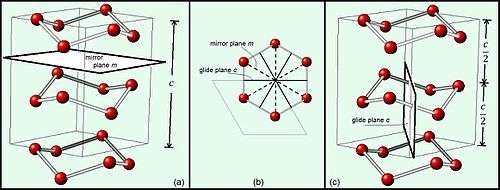
In mathematics, physics and chemistry, a space group is the symmetry group of a configuration in space, usually in three dimensions.[1] In three dimensions, there are 219 distinct types, or 230 if chiral copies are considered distinct. Space groups are also studied in dimensions other than 3 where they are sometimes called Bieberbach groups, and are discrete cocompact groups of isometries of an oriented Euclidean space.
In crystallography, space groups are also called the crystallographic or Fedorov groups, and represent a description of the symmetry of the crystal. A definitive source regarding 3-dimensional space groups is the International Tables for Crystallography (Hahn (2002)).
History
Space groups in 2 dimensions are the 17 wallpaper groups which have been known for several centuries, though the proof that the list was complete was only given in 1891, after the much harder case of space groups had been done.
In 1879 Leonhard Sohncke listed the 65 space groups (sometimes called Sohncke space groups or chiral space groups) whose elements preserve the orientation. More accurately, he listed 66 groups, but Fedorov and Schönflies both noticed that two of them were really the same. The space groups in 3 dimensions were first enumerated by Fedorov (1891) (whose list had 2 omissions (I43d and Fdd2) and one duplication (Fmm2)), and shortly afterwards were independently enumerated by Schönflies (1891) (whose list had 4 omissions (I43d, Pc, Cc, ?) and one duplication (P421m)). The correct list of 230 space groups was found by 1892 during correspondence between Fedorov and Schönflies. Barlow (1894) later enumerated the groups with a different method, but omitted four groups (Fdd2, I42d, P421d, and P421c) even though he already had the correct list of 230 groups from Fedorov and Schönflies; the common claim that Barlow was unaware of their work is a myth. Burckhardt (1967) describes the history of the discovery of the space groups in detail.
Elements
The space groups in three dimensions are made from combinations of the 32 crystallographic point groups with the 14 Bravais lattices, each of the latter belonging to one of 7 lattice systems. This results in a space group being some combination of the translational symmetry of a unit cell including lattice centering, the point group symmetry operations of reflection, rotation and improper rotation (also called rotoinversion), and the screw axis and glide plane symmetry operations. The combination of all these symmetry operations results in a total of 230 different space groups describing all possible crystal symmetries.
Elements fixing a point
The elements of the space group fixing a point of space are the identity element, reflections, rotations and improper rotations.
Translations
The translations form a normal abelian subgroup of rank 3, called the Bravais lattice. There are 14 possible types of Bravais lattice. The quotient of the space group by the Bravais lattice is a finite group which is one of the 32 possible point groups. Translation is defined as the face moves from one point to another point.
Glide planes
A glide plane is a reflection in a plane, followed by a translation parallel with that plane. This is noted by a, b or c, depending on which axis the glide is along. There is also the n glide, which is a glide along the half of a diagonal of a face, and the d glide, which is a fourth of the way along either a face or space diagonal of the unit cell. The latter is called the diamond glide plane as it features in the diamond structure. In 17 space groups, due to the centering of the cell, the glides occur in two perpendicular directions simultaneously, i.e. the same glide plane can be called b or c, a or b, a or c. For example, group Abm2 could be also called Acm2, group Ccca could be called Cccb. In 1992, it was suggested to use symbol e for such planes. The symbols for five space groups have been modified:
| Space group No. | 39 | 41 | 64 | 67 | 68 |
|---|---|---|---|---|---|
| New symbol | Aem2 | Aea2 | Cmce | Cmme | Ccce |
| Old Symbol | Abm2 | Aba2 | Cmca | Cmma | Ccca |
Screw axes
A screw axis is a rotation about an axis, followed by a translation along the direction of the axis. These are noted by a number, n, to describe the degree of rotation, where the number is how many operations must be applied to complete a full rotation (e.g., 3 would mean a rotation one third of the way around the axis each time). The degree of translation is then added as a subscript showing how far along the axis the translation is, as a portion of the parallel lattice vector. So, 21 is a twofold rotation followed by a translation of 1/2 of the lattice vector.
General formula
The general formula for the action of an element of a space group is
y = M.x + D
where M is its matrix, D is its vector, and where the element transforms point x into point y. In general, D = D(lattice) + D(M), where D(M) is a unique function of M that is zero for M being the identity. The matrices M form a point group that is a basis of the space group; the lattice must be symmetric under that point group.
The lattice dimension can be less than the overall dimension, resulting in a "subperiodic" space group. For (overall dimension, lattice dimension):
- (1,1): One-dimensional line groups
- (2,1): Two-dimensional line groups: frieze groups
- (2,2): Wallpaper groups
- (3,1): Three-dimensional line groups; with the 3D crystallographic point groups, the rod groups
- (3,2): Layer groups
- (3,3): The space groups discussed in this article
Notation
There are at least ten methods of naming space groups. Some of these methods can assign several different names to the same space group, so altogether there are many thousands of different names.
- Number. The International Union of Crystallography publishes tables of all space group types, and assigns each a unique number from 1 to 230. The numbering is arbitrary, except that groups with the same crystal system or point group are given consecutive numbers.
- International symbol or Hermann–Mauguin notation. The Hermann–Mauguin (or international) notation describes the lattice and some generators for the group. It has a shortened form called the international short symbol, which is the one most commonly used in crystallography, and usually consists of a set of four symbols. The first describes the centering of the Bravais lattice (P, A, B, C, I, R or F). The next three describe the most prominent symmetry operation visible when projected along one of the high symmetry directions of the crystal. These symbols are the same as used in point groups, with the addition of glide planes and screw axis, described above. By way of example, the space group of quartz is P3121, showing that it exhibits primitive centering of the motif (i.e., once per unit cell), with a threefold screw axis and a twofold rotation axis. Note that it does not explicitly contain the crystal system, although this is unique to each space group (in the case of P3121, it is trigonal).
- In the international short symbol the first symbol (31 in this example) denotes the symmetry along the major axis (c-axis in trigonal cases), the second (2 in this case) along axes of secondary importance (a and b) and the third symbol the symmetry in another direction. In the trigonal case there also exists a space group P3112. In this space group the twofold axes are not along the a and b-axes but in a direction rotated by 30°.
- The international symbols and international short symbols for some of the space groups were changed slightly between 1935 and 2002, so several space groups have 4 different international symbols in use.
- Hall notation. Space group notation with an explicit origin. Rotation, translation and axis-direction symbols are clearly separated and inversion centers are explicitly defined. The construction and format of the notation make it particularly suited to computer generation of symmetry information. For example, group number 3 has three Hall symbols: P 2y (P 1 2 1), P 2 (P 1 1 2), P 2x (P 2 1 1).
- Schönflies notation. The space groups with given point group are numbered by 1, 2, 3, ... (in the same order as their international number) and this number is added as a superscript to the Schönflies symbol for the point group. For example, groups numbers 3 to 5 whose point group is C2 have Schönflies symbols C1
2, C2
2, C3
2. - Fedorov notation
- Shubnikov symbol
- Strukturbericht designation is related notation for crystal structures given a letter and index: A Elements (monatomic), B for AB compounds, C for AB2 compounds, D for Am Bn compounds, (E, F, …, K More complex compounds), L Alloys, O Organic compounds, S Silicates. Some structure designation share the same space groups. For example, space group 225 is A1, B1, and C1. Space group 221 is Ah, and B2.[2] However, crystallographers would not use Strukturbericht notation to describe the space group, rather it would be used to describe a specific crystal structure (e.g. space group + atomic arrangement (motif)).
- 2D:Orbifold notation and 3D:Fibrifold notation. As the name suggests, the orbifold notation describes the orbifold, given by the quotient of Euclidean space by the space group, rather than generators of the space group. It was introduced by Conway and Thurston, and is not used much outside mathematics. Some of the space groups have several different fibrifolds associated to them, so have several different fibrifold symbols.
- Coxeter notation – Spatial and point symmetry groups, represented as modications of the pure reflectional Coxeter groups.
- Geometric notation[3] is a Geometric algebra notation.
Classification systems
There are (at least) 10 different ways to classify space groups into classes. The relations between some of these are described in the following table. Each classification system is a refinement of the ones below it.
| (Crystallographic) space group types (230 in three dimensions). Two space groups, considered as subgroups of the group of affine transformations of space, have the same space group type if they are conjugate by an orientation-preserving affine transformation. In three dimensions, for 11 of the affine space groups, there is no orientation-preserving map from the group to its mirror image, so if one distinguishes groups from their mirror images these each split into two cases. So there are 54 + 11 = 65 space group types that preserve orientation. | |
| Affine space group types (219 in three dimensions). Two space groups, considered as subgroups of the group of affine transformations of space, have the same affine space group type if they are conjugate under an affine transformation. The affine space group type is determined by the underlying abstract group of the space group. In three dimensions there are 54 affine space group types that preserve orientation. | |
| Arithmetic crystal classes (73 in three dimensions). Sometimes called Z-classes. These are determined by the point group together with the action of the point group on the subgroup of translations. In other words, the arithmetic crystal classes correspond to conjugacy classes of finite subgroup of the general linear group GLn(Z) over the integers. A space group is called symmorphic (or split) if there is a point such that all symmetries are the product of a symmetry fixing this point and a translation. Equivalently, a space group is symmorphic if it is a semidirect product of its point group with its translation subgroup. There are 73 symmorphic space groups, with exactly one in each arithmetic crystal class. There are also 157 nonsymmorphic space group types with varying numbers in the arithmetic crystal classes.
Arithmetic crystal classes may be interpreted as different orientations of the point groups in the lattice, with the group elements' matrix components being constrained to have integer coefficients in lattice space. This is rather easy to picture in the two-dimensional, wallpaper group case. Some of the point groups have reflections, and the reflection lines can be along the lattice directions, halfway in between them, or both.
| |
| (geometric) Crystal classes (32 in three dimensions). Sometimes called Q-classes. The crystal class of a space group is determined by its point group: the quotient by the subgroup of translations, acting on the lattice. Two space groups are in the same crystal class if and only if their point groups, which are subgroups of GLn(Z), are conjugate in the larger group GLn(Q). | Bravais flocks (14 in three dimensions). These are determined by the underlying Bravais lattice type.
These correspond to conjugacy classes of lattice point groups in GLn(Z), where the lattice point group is the group of symmetries of the underlying lattice that fix a point of the lattice, and contains the point group. |
| Crystal systems. (7 in three dimensions) Crystal systems are an ad hoc modification of the lattice systems to make them compatible with the classification according to point groups. They differ from crystal families in that the hexagonal crystal family is split into two subsets, called the trigonal and hexagonal crystal systems. The trigonal crystal system is larger than the rhombohedral lattice system, the hexagonal crystal system is smaller than the hexagonal lattice system, and the remaining crystal systems and lattice systems are the same. | Lattice systems (7 in three dimensions). The lattice system of a space group is determined by the conjugacy class of the lattice point group (a subgroup of GLn(Z)) in the larger group GLn(Q). In three dimensions the lattice point group can have one of the 7 different orders 2, 4, 8, 12, 16, 24, or 48. The hexagonal crystal family is split into two subsets, called the rhombohedral and hexagonal lattice systems. |
| Crystal families (6 in three dimensions). The point group of a space group does not quite determine its lattice system, because occasionally two space groups with the same point group may be in different lattice systems. Crystal families are formed from lattice systems by merging the two lattice systems whenever this happens, so that the crystal family of a space group is determined by either its lattice system or its point group. In 3 dimensions the only two lattice families that get merged in this way are the hexagonal and rhombohedral lattice systems, which are combined into the hexagonal crystal family. The 6 crystal families in 3 dimensions are called triclinic, monoclinic, orthorhombic, tetragonal, hexagonal, and cubic. Crystal families are commonly used in popular books on crystals, where they are sometimes called crystal systems. | |
Conway, Delgado Friedrichs, and Huson et al. (2001) gave another classification of the space groups, called a fibrifold notation, according to the fibrifold structures on the corresponding orbifold. They divided the 219 affine space groups into reducible and irreducible groups. The reducible groups fall into 17 classes corresponding to the 17 wallpaper groups, and the remaining 35 irreducible groups are the same as the cubic groups and are classified separately.
In other dimensions
Bieberbach's theorems
In n dimensions, an affine space group, or Bieberbach group, is a discrete subgroup of isometries of n-dimensional Euclidean space with a compact fundamental domain. Bieberbach (1911, 1912) proved that the subgroup of translations of any such group contains n linearly independent translations, and is a free abelian subgroup of finite index, and is also the unique maximal normal abelian subgroup. He also showed that in any dimension n there are only a finite number of possibilities for the isomorphism class of the underlying group of a space group, and moreover the action of the group on Euclidean space is unique up to conjugation by affine transformations. This answers part of Hilbert's eighteenth problem. Zassenhaus (1948) showed that conversely any group that is the extension of Zn by a finite group acting faithfully is an affine space group. Combining these results shows that classifying space groups in n dimensions up to conjugation by affine transformations is essentially the same as classifying isomorphism classes for groups that are extensions of Zn by a finite group acting faithfully.
It is essential in Bieberbach's theorems to assume that the group acts as isometries; the theorems do not generalize to discrete cocompact groups of affine transformations of Euclidean space. A counter-example is given by the 3-dimensional Heisenberg group of the integers acting by translations on the Heisenberg group of the reals, identified with 3-dimensional Euclidean space. This is a discrete cocompact group of affine transformations of space, but does not contain a subgroup Z3.
Classification in small dimensions
This table give the number of space group types in small dimensions, including the numbers of various classes of space group. The numbers of enantiomorphic pairs are given in parentheses.
| Dimensions | Crystal families (sequence A004032 in the OEIS) | Crystal systems (sequence A004031 in the OEIS) | Bravais lattices (sequence A004030 in the OEIS) | Abstract crystallographic point groups (sequence A006226 in the OEIS) | Geometric crystal classes, Q-classes, crystallographic point groups (sequence A004028 in the OEIS) | Arithmetic crystal classes, Z-classes (sequence A004027 in the OEIS) | Affine space group types (sequence A004029 in the OEIS) | Crystallographic space group types (sequence A006227 in the OEIS) |
|---|---|---|---|---|---|---|---|---|
| 0a | 1 | 1 | 1 | 1 | 1 | 1 | 1 | 1 |
| 1b | 1 | 1 | 1 | 2 | 2 | 2 | 2 | 2 |
| 2c | 4 | 4 | 5 | 9 | 10 | 13 | 17 | 17 |
| 3d | 6 | 7 | 14 | 18 | 32 | 73 | 219 (+11) | 230 |
| 4e | 23 (+6) | 33 (+7) | 64 (+10) | 118 | 227 (+44) | 710 (+70) | 4783 (+111) | 4894 |
| 5f | 32 | 59 | 189 | 239 | 955 | 6079 | 222018 (+79) | 222097 |
| 6g | 91 | 251 | 841 | 1594 | 7103 | 85308 (+?) | 28927915 (+?) | ? |
a - Trivial group
b - One is the group of integers and the other is the infinite dihedral group; see symmetry groups in one dimension
c - these 2D space groups are also called wallpaper groups or plane groups.
d - In 3D there are 230 crystallographic space group types, which reduces to 219 affine space group types because of some types being different from their mirror image; these are said to differ by "enantiomorphous character" (e.g. P3112 and P3212). Usually "space group" refers to 3D. They were enumerated independently by Barlow (1894), Fedorov (1891) and Schönflies (1891).
e - The 4895 4-dimensional groups were enumerated by Harold Brown, Rolf Bülow, and Joachim Neubüser et al. (1978). Neubüser, Souvignier & Wondratschek (2002) corrected the number of enantiomorphic groups from 112 to 111, so total number of groups is 4783+111=4894. There are 44 enantiomorphic point groups in 4-dimensional space. If we consider enantiomorphic groups as different, the total number of point groups is 227+44=271.
f - Plesken & Schulz (2000) enumerated the ones of dimension 5. Souvignier (2003) counted the enantiomorphs.
g - Plesken & Schulz (2000) enumerated the ones of dimension 6, later the corrected figures were found.[4] Initially published number of 826 Lattice types in Plesken & Hanrath (1984) was corrected to 841 in Opgenorth, Plesken & Schulz (1998). See also Janssen et al. (2002). Souvignier (2003) counted the enantiomorphs, but that paper relied on old erroneous CARAT data for dimension 6.
Magnetic groups and time reversal
In addition to crystallographic space groups there are also magnetic space groups (also called two-color (black and white) crystallographic groups or Shubnikov groups). These symmetries contain an element known as time reversal. They treat time as an additional dimension, and the group elements can include time reversal as reflection in it. They are of importance in magnetic structures that contain ordered unpaired spins, i.e. ferro-, ferri- or antiferromagnetic structures as studied by neutron diffraction. The time reversal element flips a magnetic spin while leaving all other structure the same and it can be combined with a number of other symmetry elements. Including time reversal there are 1651 magnetic space groups in 3D (Kim 1999, p.428). It has also been possible to construct magnetic versions for other overall and lattice dimensions (Daniel Litvin's papers, (Litvin 2008), (Litvin 2005)). Frieze groups are magnetic 1D line groups and layer groups are magnetic wallpaper groups, and the axial 3D point groups are magnetic 2D point groups. Number of original and magnetic groups by (overall, lattice) dimension:
- (0,0): 1, 2
- (1,0): 2, 5
- (1,1): 2, 7
- (2,0): 10, 31
- (2,1): 7, 31
- (2,2): 17, 80
- (3,0): 32, 122
- (3,1): 75, 394 (rod groups, not 3D line groups in general)
- (3,2): 80, 528
- (3,3): 230, 1651
- (4,0): 271, 1202
- (4,1): 343, (Palistrant 2012)
- (4,2): 1091, (Palistrant 2012)
- (4,3): 1594, (Palistrant 2012)
- (4,4): 4894, 62227 (Souvignier 2006)
Table of space groups in 2 dimensions (wallpaper groups)
Table of the wallpaper groups using the classification of the 3-dimensional space groups:
| Crystal system (Bravais lattice) |
Geometric class Point group |
Arithmetic class |
Wallpaper groups (cell diagram) | ||||||
|---|---|---|---|---|---|---|---|---|---|
| Schön. | Orbifold notation | Cox. | Ord. | ||||||
| Oblique |
C1 | (1) | [ ]+ | 1 | None | p1 (1) | |||
| C2 | (22) | [2]+ | 2 | None | p2 (2222) | ||||
| Rectangular (Centered rhombic)  |
D1 | (*) | [ ] | 2 | Along | pm (**) | pg (××) | ||
| D2 | (*22) | [2] | 4 | Along | pmm (*2222) | pmg (22*) | |||
| Rhombic (Centered rectangular)  |
D1 | (*) | [ ] | 2 | Between | cm (*×) | |||
| D2 | (*22) | [2] | 4 | Between | cmm (2*22) | pgg (22×) | |||
Square |
C4 | (44) | [4]+ | 4 | None | p4 (442) |  |
||
| D4 | (*44) | [4] | 8 | Both | p4m (*442) | 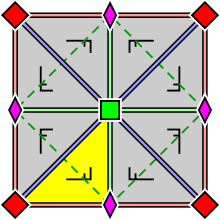 |
p4g (4*2) | 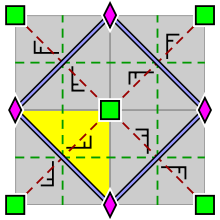 | |
Hexagonal |
C3 | (33) | [3]+ | 3 | None | p3 (333) | |||
| D3 | (*33) | [3] | 6 | Between | p3m1 (*333) | p31m (3*3) | |||
| C6 | (66) | [6]+ | 6 | None | p6 (632) | ||||
| D6 | (*66) | [6] | 12 | Both | p6m (*632) | ||||
For each geometric class, the possible arithmetic classes are
- None: no reflection lines
- Along: reflection lines along lattice directions
- Between: reflection lines halfway in between lattice directions
- Both: reflection lines both along and between lattice directions
Table of space groups in 3 dimensions
| # | Crystal system (count) Bravais lattice |
Point group | Space groups (international short symbol) | ||||
|---|---|---|---|---|---|---|---|
| Intl | Schön. | Orbifold notation | Cox. | Ord. | |||
| 1 | Triclinic (2) 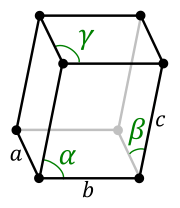 |
1 | C1 | 11 | [ ]+ | 1 | P1 |
| 2 | 1 | Ci | 1× | [2+,2+] | 2 | P1 | |
| 3–5 | Monoclinic (13) |
2 | C2 | 22 | [2]+ | 2 | P2, P21 C2 |
| 6–9 | m | Cs | *11 | [ ] | 2 | Pm, Pc Cm, Cc | |
| 10–15 | 2/m | C2h | 2* | [2,2+] | 4 | P2/m, P21/m C2/m, P2/c, P21/c C2/c | |
| 16–24 | Orthorhombic (59) |
222 | D2 | 222 | [2,2]+ | 4 | P222, P2221, P21212, P212121, C2221, C222, F222, I222, I212121 |
| 25–46 | mm2 | C2v | *22 | [2] | 4 | Pmm2, Pmc21, Pcc2, Pma2, Pca21, Pnc2, Pmn21, Pba2, Pna21, Pnn2 Cmm2, Cmc21, Ccc2, Amm2, Aem2, Ama2, Aea2 Fmm2, Fdd2 Imm2, Iba2, Ima2 | |
| 47–74 | mmm | D2h | *222 | [2,2] | 8 | Pmmm, Pnnn, Pccm, Pban, Pmma, Pnna, Pmna, Pcca, Pbam, Pccn, Pbcm, Pnnm, Pmmn, Pbcn, Pbca, Pnma Cmcm, Cmce, Cmmm, Cccm, Cmme, Ccce Fmmm, Fddd Immm, Ibam, Ibca, Imma | |
| 75–80 | Tetragonal (68) |
4 | C4 | 44 | [4]+ | 4 | P4, P41, P42, P43, I4, I41 |
| 81–82 | 4 | S4 | 2× | [2+,4+] | 4 | P4, I4 | |
| 83–88 | 4/m | C4h | 4* | [2,4+] | 8 | P4/m, P42/m, P4/n, P42/n I4/m, I41/a | |
| 89–98 | 422 | D4 | 224 | [2,4]+ | 8 | P422, P4212, P4122, P41212, P4222, P42212, P4322, P43212 I422, I4122 | |
| 99–110 | 4mm | C4v | *44 | [4] | 8 | P4mm, P4bm, P42cm, P42nm, P4cc, P4nc, P42mc, P42bc I4mm, I4cm, I41md, I41cd | |
| 111–122 | 42m | D2d | 2*2 | [2+,4] | 8 | P42m, P42c, P421m, P421c, P4m2, P4c2, P4b2, P4n2 I4m2, I4c2, I42m, I42d | |
| 123–142 | 4/mmm | D4h | *224 | [2,4] | 16 | P4/mmm, P4/mcc, P4/nbm, P4/nnc, P4/mbm, P4/mnc, P4/nmm, P4/ncc, P42/mmc, P42/mcm, P42/nbc, P42/nnm, P42/mbc, P42/mnm, P42/nmc, P42/ncm I4/mmm, I4/mcm, I41/amd, I41/acd | |
| 143–146 | Trigonal (25) 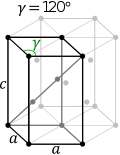  |
3 | C3 | 33 | [3]+ | 3 | P3, P31, P32 R3 |
| 147–148 | 3 | S6 | 3× | [2+,6+] | 6 | P3, R3 | |
| 149–155 | 32 | D3 | 223 | [2,3]+ | 6 | P312, P321, P3112, P3121, P3212, P3221 R32 | |
| 156–161 | 3m | C3v | *33 | [3] | 6 | P3m1, P31m, P3c1, P31c R3m, R3c | |
| 162–167 | 3m | D3d | 2*3 | [2+,6] | 12 | P31m, P31c, P3m1, P3c1 R3m, R3c | |
| 168–173 | Hexagonal (27)  |
6 | C6 | 66 | [6]+ | 6 | P6, P61, P65, P62, P64, P63 |
| 174 | 6 | C3h | 3* | [2,3+] | 6 | P6 | |
| 175–176 | 6/m | C6h | 6* | [2,6+] | 12 | P6/m, P63/m | |
| 177–182 | 622 | D6 | 226 | [2,6]+ | 12 | P622, P6122, P6522, P6222, P6422, P6322 | |
| 183–186 | 6mm | C6v | *66 | [6] | 12 | P6mm, P6cc, P63cm, P63mc | |
| 187–190 | 6m2 | D3h | *223 | [2,3] | 12 | P6m2, P6c2, P62m, P62c | |
| 191–194 | 6/mmm | D6h | *226 | [2,6] | 24 | P6/mmm, P6/mcc, P63/mcm, P63/mmc | |
| 195–199 | Cubic (36) 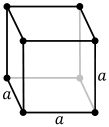 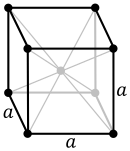 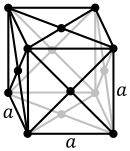 |
23 | T | 332 | [3,3]+ | 12 | P23, F23, I23 P213, I213 |
| 200–206 | m3 | Th | 3*2 | [3+,4] | 24 | Pm3, Pn3, Fm3, Fd3, Im3, Pa3, Ia3 | |
| 207–214 | 432 | O | 432 | [3,4]+ | 24 | P432, P4232 F432, F4132 I432 P4332, P4132, I4132 | |
| 215–220 | 43m | Td | *332 | [3,3] | 24 | P43m, F43m, I43m P43n, F43c, I43d | |
| 221–230 | m3m | Oh | *432 | [3,4] | 48 | Pm3m, Pn3n, Pm3n, Pn3m Fm3m, Fm3c, Fd3m, Fd3c Im3m, Ia3d | |
Note. An e plane is a double glide plane, one having glides in two different directions. They are found in seven orthorhombic, five tetragonal and five cubic space groups, all with centered lattice. The use of the symbol e became official with Hahn (2002).
The lattice system can be found as follows. If the crystal system is not trigonal then the lattice system is of the same type. If the crystal system is trigonal, then the lattice system is hexagonal unless the space group is one of the seven in the rhombohedral lattice system consisting of the 7 trigonal space groups in the table above whose name begins with R. (The term rhombohedral system is also sometimes used as an alternative name for the whole trigonal system.) The hexagonal lattice system is larger than the hexagonal crystal system, and consists of the hexagonal crystal system together with the 18 groups of the trigonal crystal system other than the seven whose names begin with R.
The Bravais lattice of the space group is determined by the lattice system together with the initial letter of its name, which for the non-rhombohedral groups is P, I, F, or C, standing for the principal, body centered, face centered, or C-face centered lattices.
References
- ↑ Hiller, Howard (1986). "Crystallography and cohomology of groups". Amer. Math. Monthly. 93 (10): 765–779. doi:10.2307/2322930. JSTOR 2322930.
- ↑ "Strukturbericht - Wikimedia Commons". commons.wikimedia.org.
- ↑ PDF The Crystallographic Space Groups in Geometric Algebra, David Hestenes and Jeremy Holt
- ↑ "The CARAT Homepage". Retrieved 11 May 2015.
- Barlow, W (1894), "Über die geometrischen Eigenschaften starrer Strukturen und ihre Anwendung auf Kristalle", Z. Kristallogr., 23: 1–63, doi:10.1524/zkri.1894.23.1.1
- Bieberbach, Ludwig (1911), "Über die Bewegungsgruppen der Euklidischen Räume", Mathematische Annalen, 70 (3): 297–336, doi:10.1007/BF01564500, ISSN 0025-5831
- Bieberbach, Ludwig (1912), "Über die Bewegungsgruppen der Euklidischen Räume (Zweite Abhandlung.) Die Gruppen mit einem endlichen Fundamentalbereich", Mathematische Annalen, 72 (3): 400–412, doi:10.1007/BF01456724, ISSN 0025-5831
- Brown, Harold; Bülow, Rolf; Neubüser, Joachim; Wondratschek, Hans; Zassenhaus, Hans (1978), Crystallographic groups of four-dimensional space, New York: Wiley-Interscience [John Wiley & Sons], ISBN 978-0-471-03095-9, MR 0484179
- Burckhardt, Johann Jakob (1947), Die Bewegungsgruppen der Kristallographie, Lehrbücher und Monographien aus dem Gebiete der exakten Wissenschaften, 13, Verlag Birkhäuser, Basel, MR 0020553
- Burckhardt, Johann Jakob (1967), "Zur Geschichte der Entdeckung der 230 Raumgruppen", Archive for History of Exact Sciences, 4 (3): 235–246, doi:10.1007/BF00412962, ISSN 0003-9519, MR 0220837
- Conway, John Horton; Delgado Friedrichs, Olaf; Huson, Daniel H.; Thurston, William P. (2001), "On three-dimensional space groups", Beiträge zur Algebra und Geometrie. Contributions to Algebra and Geometry, 42 (2): 475–507, ISSN 0138-4821, MR 1865535
- Fedorov, E. S. (1891), "Symmetry of Regular Systems of Figures", Zap. Mineral. Obch., 28 (2): 1–146
- Fedorov, E. S. (1971), Symmetry of crystals, ACA Monograph, 7, American Crystallographic Association
- Hahn, Th. (2002), Hahn, Theo, ed., International Tables for Crystallography, Volume A: Space Group Symmetry, International Tables for Crystallography, A (5th ed.), Berlin, New York: Springer-Verlag, doi:10.1107/97809553602060000100, ISBN 978-0-7923-6590-7
- Hall, S.R. (1981), "Space-Group Notation with an Explicit Origin", Acta Crystallogr. A, 37 (4): 517–525, Bibcode:1981AcCrA..37..517H, doi:10.1107/s0567739481001228
- Janssen, T.; Birman, J.L.; Dénoyer, F.; Koptsik, V.A.; Verger-Gaugry, J.L.; Weigel, D.; Yamamoto, A.; Abrahams, S.C.; Kopsky, V. (2002), "Report of a Subcommittee on the Nomenclature of n-Dimensional Crystallography. II. Symbols for arithmetic crystal classes, Bravais classes and space groups", Acta Crystallogr. A, 58 (Pt 6): 605–621, doi:10.1107/S010876730201379X
- Kim, Shoon K. (1999), Group theoretical methods and applications to molecules and crystals, Cambridge University Press, doi:10.1017/CBO9780511534867, ISBN 978-0-521-64062-6, MR 1713786
- Litvin, D.B. (May 2008), "Tables of crystallographic properties of magnetic space groups", Acta Crystallogr. A, 64 (Pt 3): 419–24, Bibcode:2008AcCrA..64..419L, doi:10.1107/S010876730800768X, PMID 18421131
- Litvin, D.B. (May 2005), "Tables of properties of magnetic subperiodic groups", Acta Crystallogr. A, 61 (Pt 3): 382–5, Bibcode:2005AcCrA..61..382L, doi:10.1107/S010876730500406X, PMID 15846043
- Neubüser, J.; Souvignier, B.; Wondratschek, H. (2002), "Corrections to Crystallographic Groups of Four-Dimensional Space by Brown et al. (1978) [New York: Wiley and Sons]", Acta Crystallogr. A, 58 (Pt 3): 301, doi:10.1107/S0108767302001368, PMID 11961294
- Opgenorth, J; Plesken, W; Schulz, T (1998), "Crystallographic Algorithms and Tables", Acta Crystallogr. A, 54 (Pt 5): 517–531, doi:10.1107/S010876739701547X
- Palistrant, A. F. (2012), "Complete Scheme of Four-Dimensional Crystallographic Symmetry Groups", Crystallography Reports, 57 (4): 471–477, Bibcode:2012CryRp..57..471P, doi:10.1134/S1063774512040104
- Plesken, Wilhelm; Hanrath, W (1984), "The lattices of six-dimensional space", Math. Comp., 43 (168): 573–587, doi:10.1090/s0025-5718-1984-0758205-5
- Plesken, Wilhelm; Schulz, Tilman (2000), "Counting crystallographic groups in low dimensions", Experimental Mathematics, 9 (3): 407–411, doi:10.1080/10586458.2000.10504417, ISSN 1058-6458, MR 1795312
- Schönflies, Arthur Moritz (1891), "Theorie der Kristallstruktur", Gebr. Bornträger, Berlin.
- Souvignier, Bernd (2006), "The four-dimensional magnetic point and space groups", Z. Kristallogr., 221: 77–82, Bibcode:2006ZK....221...77S, doi:10.1524/zkri.2006.221.1.77
- Vinberg, E. (2001) [1994], "Crystallographic group", in Hazewinkel, Michiel, Encyclopedia of Mathematics, Springer Science+Business Media B.V. / Kluwer Academic Publishers, ISBN 978-1-55608-010-4
- Zassenhaus, Hans (1948), "Über einen Algorithmus zur Bestimmung der Raumgruppen", Commentarii Mathematici Helvetici, 21: 117–141, doi:10.1007/BF02568029, ISSN 0010-2571, MR 0024424
- Souvignier, Bernd (2003), "Enantiomorphism of crystallographic groups in higher dimensions with results in dimensions up to 6", Acta Crystallogr. A, 59 (3): 210–220, doi:10.1107/S0108767303004161
External links
| Wikimedia Commons has media related to Space groups. |
- International Union of Crystallography
- Point Groups and Bravais Lattices
- Bilbao Crystallographic Server
- Space Group Info (old)
- Space Group Info (new)
- Crystal Lattice Structures: Index by Space Group
- Full list of 230 crystallographic space groups
- Interactive 3D visualization of all 230 crystallographic space groups
- Huson, Daniel H. (1999), The Fibrifold Notation and Classification for 3D Space Groups (PDF)
- The Geometry Center: 2.1 Formulas for Symmetries in Cartesian Coordinates (two dimensions)
- The Geometry Center: 10.1 Formulas for Symmetries in Cartesian Coordinates (three dimensions)